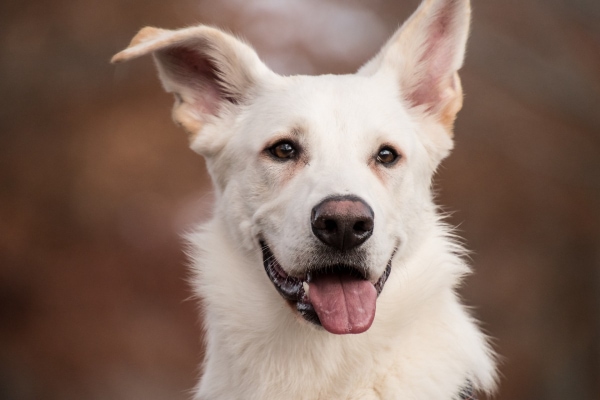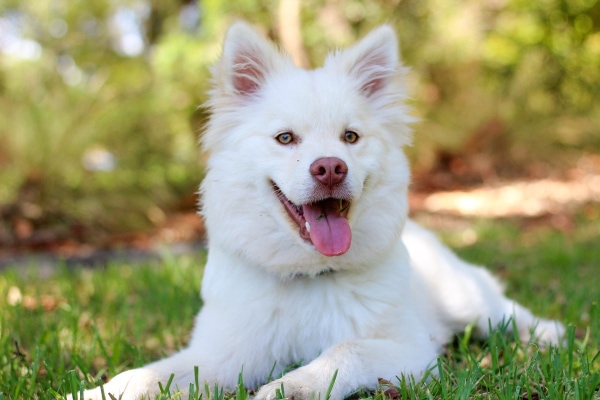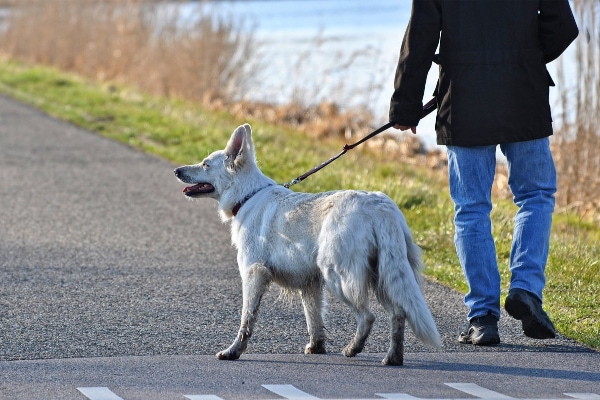Easy Name for German Shepherd for Deaf People Can Say
Communicating with a deaf dog presents unique challenges, but these special pups are certainly able to understand us. Integrative veterinarian Dr. Julie Buzby outlines some ways to effectively communicate with your deaf dog.

Can my deaf dog understand me?
A dog experiences the world differently from you and me. Dogs utilize all manners of non-verbal communication. Even hearing dogs rely heavily on body language. Think about your interactions with dogs, or witnessing dogs interacting with each other. Here are just a few examples:
- Posture – Is the dog upright and confident, or crouched and cowering?
- Ear position – Are the dog's ears pinned back, relaxed, erect?
- Tail position – Is the dog's tail tucked, held upright, or wagging?
Deaf dogs may not be able to hear our words or tone, or other dogs' barks, growls, and whimpers, but they certainly understand body language just like any other dog!
What causes hearing loss in dogs?
The Deaf Dog Education Action Fund (DDEAF) reports that dogs lose their hearing for many of the same reasons people go deaf. Genetic defects can cause a puppy to be born deaf and adult dogs can lose their hearing due to chronic ear infections (i.e. otitis in dogs), an injury to the ear, exposure to loud noises, and as an uncommon side effect from ear medications.
Seniors dogs are also prone to gradual deafness due to old age. Sometimes older dogs can hear higher-pitched noises like whistles or clicks more easily than human voices.

Some breeds are more prone to congenital deafness. Typically, breeds that have white pigmentation, such as Dalmatians and Australian Shepherds, are at an increased risk of congenital deafness, although it can occur in any breed. Pigment cells in the inner ear are vital for normal hearing, so dogs with white pigment on the head and face may also lack these pigment cells in their ears.
How do I know if my dog is deaf?
The most accurate way to tell if your dog is deaf is with the BAER (Brainstem Auditory Evoked Response) test. The procedure uses computers to record the electrical activity of the brain in response to specific sounds and pitches.
BAER testing is typically performed by a veterinary neurologist and may not be offered by your regular veterinarian. As an alternative if this test is unavailable to you, DDEAF also recommends this do-it-yourself test to determine hearing loss:
- Jangle keys or a can of coins.
- Squeak a toy while it is behind your back.
- Call your dog's name in a normal voice. Then try yelling the name.
- Clap your hands. (You should be far enough away so that he doesn't feel air movement.)
- Turn on a vacuum cleaner. (Be sure it's far enough away from the dog so that the vibrations or airflow don't reach him.)
- Ring the doorbell.
Dogs who do not react to these auditory stimuli may have some degree of hearing loss. If you're concerned that your dog may have hearing loss, consult with your veterinarian.
If your dog is diagnosed with deafness or hearing loss, you will probably be more upset about it than your dog will be. Dogs are resilient and don't feel sorry for themselves.

How can I communicate with my deaf dog?
Dogs do not communicate the way humans do. Dogs tell each other about themselves through visual body cues and scent before adding verbal signs like barking, growling, or whining. That's why communicating with your deaf dog through hand signals is an effective communication strategy.
Using hand signals to communicate
DDEAF recommends pet parents use standard obedience training hand signals or learn American Sign Language (ASL) to communicate with their dog. DDEAF suggests starting by teaching your dog the signs for sit, down, stay come, no, and stop. Dogs with hearing loss have been known to learn 20 hand signals or more once they get the idea.
Even hearing dogs can benefit from learning visual cues. The secret is to teach clear and consistent hand signals and confirm that your dog understands what you want them to do.
For dogs with gradual hearing loss, hand signals can be used in conjunction with verbal cues to "bridge the gap" making the connection before dogs develop complete deafness.
Here's a video that shows how to communicate with your deaf dog through basic signals using American Sign Language. Also, you can pick up the American Sign Language handbook at most book stores or online.
Are deaf dogs trainable?
Training a deaf dog can be challenging, but it's certainly not impossible! The most important thing to remember is, just like any dog, hearing impaired dogs respond best to positive reinforcement. In other words, lots of treats!
Punishment should be avoided as a training method, particularly for dogs who have extra challenges understanding us.

Establish eye contact
Teach your dog to make frequent eye contact. If he's not looking at you, he can't respond to hand signals. This should be one of the first focuses of training because it is vital for your dog to look at you to know what other commands to follow.
To start, reward eye contact. You can use a cue such as a flashing light or stomping on the ground to prompt your dog to look at you. Whenever he or she makes eye contact, give positive feedback and treats. It won't take long for your dog to learn that eye contact equals yummy rewards!
Use a flashlight
One of the most popular and effective methods of training a dog is clicker training. In its most basic form, clicker training makes a positive association between a sound (click) and a reward (treat), which is later substituted to reward the desired behavior with a click so that the dog knows he or she has done something well.
Obviously, clicker training needs a bit of a work-around for deaf dogs, as they cannot hear the click. Flashlight training uses the same principles, but with a flashlight in place of a clicker. You can use a quick flash of a flashlight, or even flickering the room lights, to convey to your dog that they've done something good, such as making eye contact or responding to a hand signal.
Safety first
One of the major concerns in owning a deaf dog is keeping them safe. Deaf dogs can't hear an oncoming car and won't be able to hear you call their name if they get lost. So it is extremely important to keep your deaf dog inside the house or in a fenced yard while at home or on a leash if you are out in public.

Recall is an important skill for any dog to learn. However, it is even more important for dogs with hearing loss because they can't hear oncoming danger and they can't hear you calling them. Develop a cue that works for you and your dog, such as flashing lights or waving to get his attention. Some pet parents opt for a vibrating collar to get their dog's attention from a distance.
Important note: Shock collars should not be used!
Once you have your dog's attention, reward him or her for coming straight back to you. Repeating this process consistently will teach your dog to look to you and/or return to you on command, and may save him or her from a dangerous situation.
Avoid startling
One important concern is to prevent startling a deaf dog. Deaf dogs are statistically more likely to bite people, but many of these incidents are reactions to deaf dogs being startled.

Whether they are asleep or awake, a deaf dog will not know you are approaching so it is best to tread lightly. DDEAF recommends you stomp on the floor as you approach so your dog can feel the vibrations when you are walking toward them. If you have to touch your dog to wake him or get his attention, lightly tap the dog on the shoulder or rump to let him know you are there.
It is essential that children who share a home with a deaf dog are taught how to approach a deaf dog and interact with them appropriately.
Enjoy your time together
With a few adjustments, dogs with deafness can lead normal and happy lives.
Have you lived with a dog with a hearing loss?
We'd love to hear your story, Please comment below.
schaefernouse1990.blogspot.com
Source: https://toegrips.com/communicate-deaf-dog/
0 Response to "Easy Name for German Shepherd for Deaf People Can Say"
Post a Comment